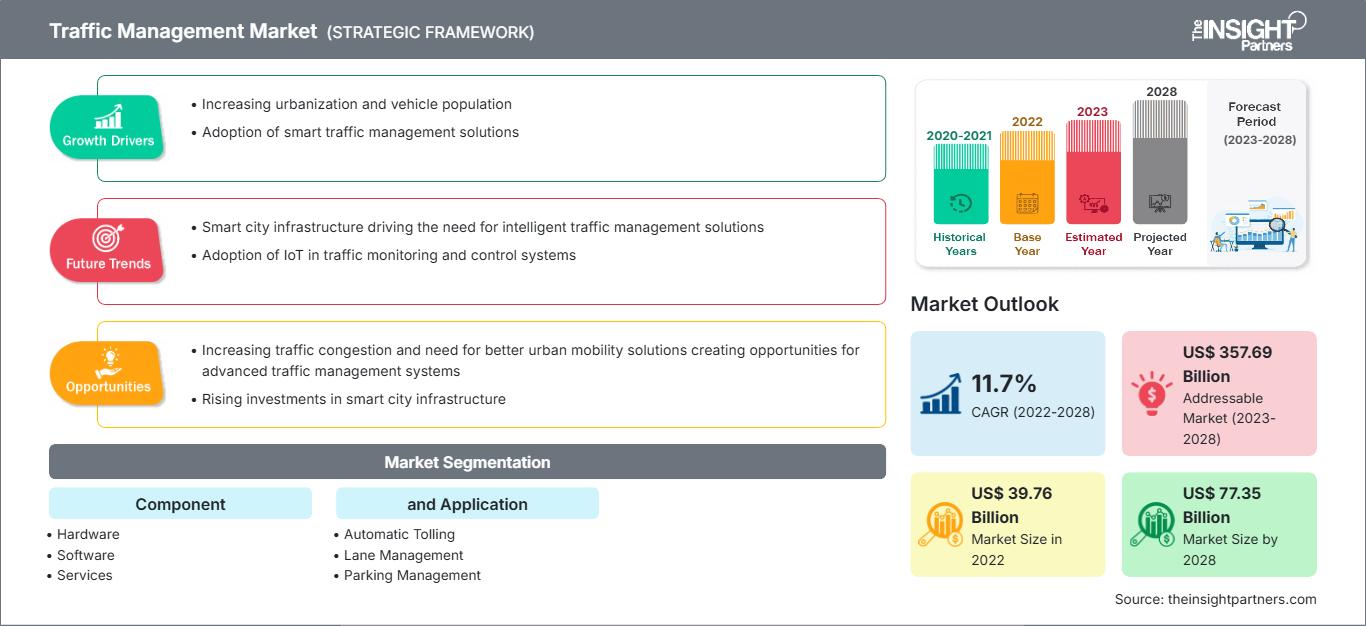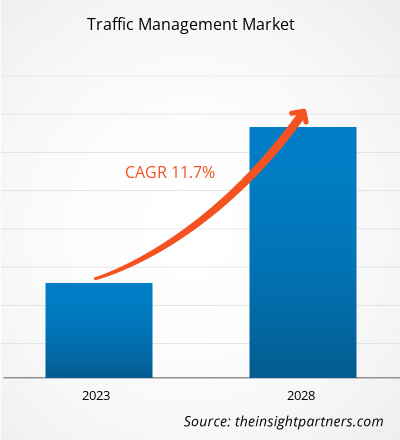Le marché de la gestion du trafic devrait atteindre 77 346,44 millions de dollars américains d'ici 2028, contre 39 756,74 millions de dollars américains en 2022 ; il devrait croître à un TCAC de 11,7 % entre 2022 et 2028.
La plupart des pays ont connu une urbanisation drastique au fil des ans, ce qui a entraîné des réseaux routiers complexes et une forte congestion. L'augmentation de la population urbaine, conjuguée à la possession croissante de véhicules privés, augmente le nombre de véhicules sur les routes. La population de Mumbai, en Inde, est passée de 18,5 millions en 2011 à 20,4 millions en 2020, tandis que le nombre de véhicules privés a presque doublé au cours de cette période. En raison de ces facteurs, et pour y remédier, la croissance du marché de la gestion du trafic est estimée. De plus, les services de VTC des agrégateurs de taxis, tels qu'Uber, Grab, Ola et Lyft, ont connu une croissance rapide. Ces services ont remplacé les systèmes de transport en commun, entraînant une forte augmentation du nombre de véhicules sur les routes. Ces facteurs obligent les autorités gouvernementales à se rapprocher des acteurs du marché de la gestion du trafic pour trouver des solutions efficaces. Les embouteillages peuvent être efficacement réduits grâce à un système de gestion du trafic robuste, comprenant des logiciels, des capteurs, des caméras et des panneaux d'affichage. Ces systèmes peuvent être installés sur une route existante sans nécessiter de modification des infrastructures. De même, un système de gestion des voies peut gérer efficacement le flux de circulation en ouvrant ou en fermant des voies, en fonction du débit de circulation à chaque instant. Compte tenu des avantages offerts par les systèmes de gestion du trafic, le taux d'urbanisation rapide devrait fortement stimuler la taille du marché de la gestion du trafic.
Impact de la pandémie de COVID-19 sur la croissance du marché de la gestion du trafic
L'épidémie de COVID-19 a perturbé des secteurs d'activité tels que l'automobile, l'industrie manufacturière, l'énergie et l'électricité, l'aérospatiale et Défense et construction en 2020. La croissance continue du nombre de patients atteints de la COVID-19 a contraint les autorités gouvernementales américaines et étrangères à imposer des confinements stricts au cours des trois premiers trimestres de 2020. Cela a entraîné une baisse significative des transports dans tous les pays. La mise en œuvre de mesures de confinement telles que les interdictions commerciales, les restrictions de voyage et les limitations de main-d'œuvre a eu un impact sur les activités de fabrication, d'approvisionnement et de vente de diverses entreprises, y compris les sociétés fournissant du matériel, des logiciels et des services de gestion du trafic. Le secteur manufacturier a subi de lourdes pertes en raison de fermetures temporaires d'usines et de faibles volumes de production, ce qui a également entravé la production de systèmes matériels de gestion du trafic. Aux États-Unis, les gouvernements fédéral et étatiques se sont davantage concentrés sur la lutte contre la pandémie ; en conséquence, l'installation de matériel et de logiciels de gestion du trafic a été temporairement suspendue. Le secteur européen de la gestion du trafic a été durement touché par une baisse d'environ 20 % des dépenses liées aux projets d'infrastructure, ce qui a entraîné des retards et l'arrêt de plusieurs projets de villes et de routes intelligentes. La hausse des prix des semi-conducteurs et la perturbation des chaînes d'approvisionnement ont encore aggravé la situation. Cependant, le marché de la gestion du trafic a commencé à connaître une croissance positive au quatrième trimestre 2020.
Personnalisez ce rapport en fonction de vos besoins
Vous bénéficierez d’une personnalisation sur n’importe quel rapport - gratuitement - y compris des parties de ce rapport, ou une analyse au niveau du pays, un pack de données Excel, ainsi que de profiter d’offres exceptionnelles et de réductions pour les start-ups et les universités
Marché de la gestion du trafic: Perspectives stratégiques

- Obtenez les principales tendances clés du marché de ce rapport.Cet échantillon GRATUIT comprendra une analyse de données, allant des tendances du marché aux estimations et prévisions.
Vous bénéficierez d’une personnalisation sur n’importe quel rapport - gratuitement - y compris des parties de ce rapport, ou une analyse au niveau du pays, un pack de données Excel, ainsi que de profiter d’offres exceptionnelles et de réductions pour les start-ups et les universités
Marché de la gestion du trafic: Perspectives stratégiques

- Obtenez les principales tendances clés du marché de ce rapport.Cet échantillon GRATUIT comprendra une analyse de données, allant des tendances du marché aux estimations et prévisions.
Analyses du marché – Marché de la gestion du trafic
Le monde assiste à un essor des appareils connectés, et plusieurs pays investissent dans le développement de villes intelligentes. Ces villes sont des zones urbaines technologiquement avancées qui utilisent divers capteurs et méthodes électroniques pour collecter des données et les exploiter au profit de la localité. Les villes intelligentes sont conçues avec des plans à long terme pour gérer le trafic en optimisant les transports et la logistique et en réduisant les embouteillages. Par conséquent, parallèlement aux villes intelligentes, les pays investissent également dans le développement de routes intelligentes pour des déplacements plus sûrs. Sur ces routes, différents types de capteurs et de matériel collectent des données multivariées utilisées pour surveiller le trafic. Ces données peuvent également être partagées avec les véhicules circulant sur la route, permettant aux conducteurs et aux usagers de prendre des décisions éclairées. Par conséquent, l'adoption croissante des villes et des routes intelligentes devrait stimuler la taille du marché de la gestion du trafic.
Analyses basées sur les composants
Le marché de la gestion du trafic est segmenté en fonction des composants, des applications et de la géographie. Le marché, par composant, est segmenté en matériel, logiciels et services. Le marché du matériel est lui-même segmenté en caméras, panneaux d'affichage et capteurs ; le marché des logiciels est quant à lui divisé entre cloud et sur site. Différentes agences gouvernementales ont investi dans la modernisation de leur matériel de gestion du trafic. L'urbanisation croissante et l'augmentation du nombre de véhicules ont alourdi les routes urbaines. Les autorités s'appuient donc sur des caméras modernes pour mieux gérer la circulation et garantir la sécurité. Les caméras de reconnaissance automatique des plaques d'immatriculation (ANPR) sont de plus en plus déployées pour identifier les contrevenants ou localiser les véhicules lors des enquêtes sur les incidents. Elles sont souvent associées à des capteurs laser pour déterminer la vitesse d'un véhicule.
Par application, le marché de la gestion du trafic est segmenté en péage automatique, gestion des voies, gestion du stationnement, surveillance, gestion des feux de circulation, etc. Géographiquement, le marché est principalement segmenté en Amérique du Nord, Europe, Asie-Pacifique (APAC), Moyen-Orient et Afrique (MEA) et Amérique du Sud (SAM). IBM Corporation ; Cisco Systems, Inc. ; Siemens AG ; Hangzhou Hikvision Digital Technology Co., Ltd. et Dahua Technology Co., Ltd. comptent parmi les principaux acteurs du marché de la gestion du trafic.
Aperçu régional du marché de la gestion du trafic
Les tendances régionales et les facteurs influençant le marché de la gestion du trafic tout au long de la période de prévision ont été analysés en détail par les analystes de The Insight Partners. Cette section aborde également les segments et la géographie du marché de la gestion du trafic en Amérique du Nord, en Europe, en Asie-Pacifique, au Moyen-Orient et en Afrique, ainsi qu'en Amérique du Sud et en Amérique centrale.
Portée du rapport sur le marché de la gestion du trafic
| Attribut de rapport | Détails |
|---|---|
| Taille du marché en 2022 | US$ 39.76 Billion |
| Taille du marché par 2028 | US$ 77.35 Billion |
| TCAC mondial (2022 - 2028) | 11.7% |
| Données historiques | 2020-2021 |
| Période de prévision | 2023-2028 |
| Segments couverts |
By Composant
|
| Régions et pays couverts | Amérique du Nord
|
| Leaders du marché et profils d'entreprises clés |
|
Densité des acteurs du marché de la gestion du trafic : comprendre son impact sur la dynamique des entreprises
Le marché de la gestion du trafic connaît une croissance rapide, portée par une demande croissante des utilisateurs finaux, due à des facteurs tels que l'évolution des préférences des consommateurs, les avancées technologiques et une meilleure connaissance des avantages du produit. Face à cette demande croissante, les entreprises élargissent leur offre, innovent pour répondre aux besoins des consommateurs et capitalisent sur les nouvelles tendances, ce qui alimente la croissance du marché.

- Obtenez le Marché de la gestion du trafic Aperçu des principaux acteurs clés
- Analyse historique (2 ans), année de base, prévision (7 ans) avec TCAC
- Analyse PEST et SWOT
- Taille du marché Valeur / Volume - Mondial, Régional, Pays
- Industrie et paysage concurrentiel
- Ensemble de données Excel
Rapports récents
Rapports connexes
Témoignages
Raison d'acheter
- Prise de décision éclairée
- Compréhension de la dynamique du marché
- Analyse concurrentielle
- Connaissances clients
- Prévisions de marché
- Atténuation des risques
- Planification stratégique
- Justification des investissements
- Identification des marchés émergents
- Amélioration des stratégies marketing
- Amélioration de l'efficacité opérationnelle
- Alignement sur les tendances réglementaires




















 Obtenez un échantillon gratuit pour - Marché de la gestion du trafic
Obtenez un échantillon gratuit pour - Marché de la gestion du trafic